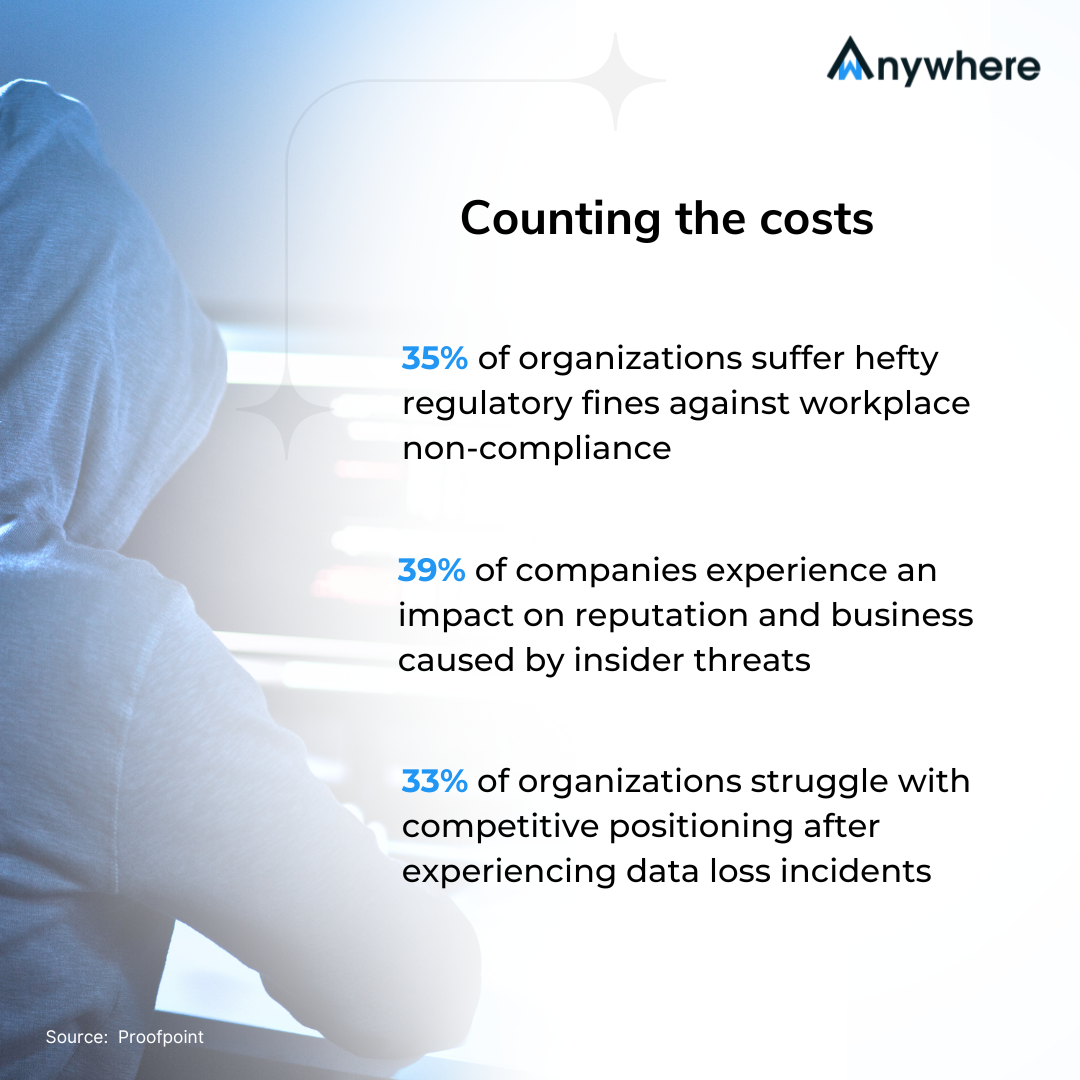Proofpoint Threat Report 2024 indicates that 80% of industries experience negative consequences due to growing data breach incidents. Rising instances of workplace non-compliance and unauthorized data exposure mostly involve threats within organizations (70%), including intentional, unintentional, and accidental internals. The alarming insider threat landscape hints at the high demand for data-critical businesses to implement a robust incident response plan and strengthen their security posture.
Table of Contents
The increasing challenge of insider attacks is impacting industries – especially those with data-sensitive operations, including Banking, Finance Services, and Insurance – as Proofpoint survey adds companies experience 57% of business disruptions and revenue loss as a consequence of data breach incidents caused by malicious internals. Identifying the subtle signs of attacks from within the organization adds to the complexity of the challenge of detecting and controlling insider threats before they cause harm. The Proofpoint 2024 report supports this fact by revealing that 90% of companies find detecting insider attacks challenging.

Leveraging AI-driven security and compliance can help the concerned organizations gain advanced capabilities to analyze how employees in data-sensitive roles working in office, remote, and hybrid environments behave and find whether their actions are indicative of threats to respond ahead of time and prevent threats from happening.
Let’s first understand what are the prime reasons that lead to insider attacks in organizations:
What are the top causes of data breach instances
From malicious apps and web usage to insiders taking advantage of their authority to expose intellectual property, and the absence of a strong security system for fraud prevention to the costliest PII information exfiltration – these unfortunate events are causing organizations the most harm.
Risky app and web usage
Proofpoint security report shows that 21% of communication tools are involved in storing information and transferring documents and images.
Intellectual property (IP) or data theft
A DTEX security analysis reveals that 43% of Intellectual Property theft was caused by departing employees and healthcare is the second most targeted industry with 20% IP theft.
Smaller organizations face higher data breach cost
DTEX report indicates that in 2023, companies with more than 5,000 employees experienced average data breach cost decreased to USD 5.46mn from USD 5.56mn, down by 1.8% compared to 2022. On the other hand, organizations with 5,000 or fewer employees experienced a considerable increase in average data breach cost of USD 2.71mn from USD 3.29mn, up by 13.4% compared to 2022.
Compromised customer PII – the costliest and most common
DTEX Insider Threat Report highlights that customer PII was the most commonly breached record type in previous years of 2021 and 2022. The trend followed in 2023, and overall, 52% of all breaches involved compromised customer PII including Names and Social Security Numbers, costing the concerned organizations USD 183 per record.
Why is need for a robust insider threat response plan
About 79% of organizations say they have not fully implemented security against the incrementing data threats (involving 74% of malicious insiders, 63% of inadvertent insiders, and 58% of negligent insiders). It indicates an urgent need for organizations, including financial services with data-intensive operations, to implement a firm security system in place and mitigate risks.
Act ahead of threats and stop the potential damage
Stay alerted and control insider activities hinting at threats to avoid workplace non-compliance and loss of business reputation and revenue.
Control the risk and impact of malicious insiders
Gain the capability to identify and act ahead of malicious insiders to avoid potential disruptions to your business operations and hefty regulatory fines.
Align teams with regulatory compliance best practices
Implement regulatory compliance and measure employee actions to help them align with the essential data protection rules and contribute to workplace efficiency.
What is the role of wAnywhere AI security and compliance
The Proofpoint Threat Report discloses that 70% of organizations face the challenge of gaining visibility into sensitive business data, risky user behavior, and internal threats to defend against malicious insiders and ensure industry regulations including GDPR, HIPAA, SOC 2, ISO 27001, PCI DSS, and more.
By integrating AI security and compliance solutions into your sensitive business operations, you can gain advanced capabilities to get insider threat awareness with real-time alerts against risky internal activities indicating threats and effectively respond before they cause harm.
Behavioral and predictive analytics
Define automated alerts to trigger corrective actions against risky employee moves indicating risks to stop the potential damage to workplace compliance and business operations.
Threat detection and prevention
Identify malicious insiders and control them to negate possible data breach risks. Analyze the data to find what business assets are at most stake and what factors motivate insiders to commit data breaches. Decide on preventive measures to avoid vulnerabilities and align teams to industry regulations and operational efficiency.
Workplace compliance and data privacy
Enable workplace compliance and enterprise risk management to ensure your workforce operates in accordance with defined regulations and strengthen security posture in your data-critical business environment.
Ensure industry regulations and achieve operational efficiency
Controlling careless users is critical as they cause the most harm (71%) to data privacy in organizations with data-centric business operations – indicates Proofpoint Threat Report 2024. Gain a firm check over increasing data threat incidents involving malicious insiders. Start your wAnywhere experience today and know how it helps strengthen the security posture in your organization.
Why do you need a firm incident response plan and what is the role of AI security?
Ever-growing instances of insider threat indicate an urgent need for implementing strong security measures to control workplace non-compliance and business data breaches. Leverage automated threat detection and prevention capabilities of AI security to respond firmly against increasing risks to business data privacy.
Why is workplace compliance important to ensure business data privacy?
Workplace aligned with regulatory policies ensures workforce actions are in accordance with defined security rules. Teams following compliance at work make fewer mistakes leading to data threats than those who don’t.
wAnywhere Blog
Check out the wAnywhere blog to learn more about our product, customer stories, and our take on meetings, remote working, productivity, and more.



